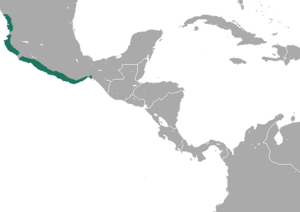Pygmy spotted skunk facts for kids
The pygmy spotted skunk (its scientific name is Spilogale pygmaea) is a small mammal. It belongs to the Mephitidae family, which includes all skunks. This special skunk only lives in Mexico. It's one of the smallest skunks in the world!
Quick facts for kids Pygmy spotted skunk |
|
|---|---|
| Conservation status | |
| Scientific classification | |
| Genus: |
Spilogale
|
| Species: |
pygmaea
|
 |
|
|
Pygmy spotted skunk range
|
|
Contents
Where Pygmy Skunks Live
The pygmy skunk lives along the Pacific coast of Mexico. You can find it in woodlands and thickets. These areas usually have rocky soil. They stay away from dense forests and swampy places. Pygmy skunks often make their homes in burrows. They can also hide in trees if they need to.
What Pygmy Skunks Look Like
Pygmy spotted skunks look a lot like weasels. They have a slim body. Their tail is thinner and smaller than other skunks' tails. These skunks can grow to be about 11.5 to 34.5 centimeters long. Their tail adds another 7 to 12 centimeters.
Their fur is mostly black. They have white spots on their forehead. They also have 2 to 6 white stripes on their back and sides. These stripes often turn into spots as they get older. The tip of their tail is usually white. Like all skunks, they have two large scent glands. These glands are near their tail. They use them to spray a strong, smelly liquid.
Pygmy Skunk Life Cycle
Pygmy skunks usually mate in September or October. But the baby skunks don't start growing right away. This is called delayed implantation. The embryo waits until March or April of the next year to begin developing. Once it starts, the baby skunks grow for about 28 to 31 days. So, from mating to birth, it takes about 230 to 250 days.
Female skunks can give birth to up to 10 babies at a time. The young skunks get their final fur color after 21 days. They open their eyes when they are about 32 days old. They can spray musk when they are 46 days old. They stop drinking their mother's milk after two months. They reach their full adult size by 15 weeks. They are ready to have their own babies by the next mating season. Young skunks usually leave their mothers in the fall. But sometimes, they stay with their mothers through the winter. They might even share a den with other skunks.
What Pygmy Skunks Eat
This skunk is an omnivore. This means it eats both plants and animals. However, it eats more meat than other skunks. In the summer, it mainly eats insects, fruits, and berries. In the winter, it hunts small mammals, birds, and reptiles. They are good climbers. They can climb trees to catch their prey. Sometimes, they even sneak into chicken coops to steal eggs!
Pygmy Skunk Behavior
Young skunks sometimes go with their mothers on hunting trips at night. These skunks often share large nests in the winter. But they do not hibernate, which means they don't go into a deep sleep all winter. Pygmy skunks are strictly nocturnal. This means they are only active at night.
If a pygmy skunk feels threatened, its first reaction is to run away. If it gets cornered, it can become aggressive. It will bristle its fur and raise its tail to look bigger. It might even stand on its front legs. It can walk towards an attacker in this position. If the danger continues, it will go back to standing on four legs. Then it will curl its body into a "U" shape. It points its tail right at its enemy. That's when it sprays its stinky liquid!
Protecting Pygmy Skunks
The pygmy spotted skunk is listed as a vulnerable species. This means its population is shrinking. Scientists believe its numbers have dropped by up to 30% in 15 years. This is mainly because their habitat is being lost. The places where they live are being developed. This is often for tourism in Mexico.
Pygmy skunks can live in different types of habitats. They can even survive in areas where humans are present. But dogs and cats can be a threat to them.


